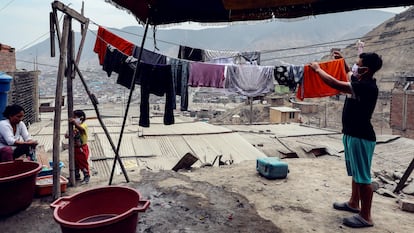Latin America, in the hands of Wall Street
The average gross debt of governments is 77.7% of regional GDP, making it the most-indebted emerging region in the world


Sitting next to a Costa Rica flag and with a fixed stare, President Carlos Alvarado did not hold back when expressing his frustration with the global financial system. “Other players have a responsibility to support the financing of our region,” he said, speaking during a virtual event organized by various multilateral institutions this month. “The pandemic has clearly shown that we are not all OK until all of us are OK,” he added.
Latin America is the most-indebted emerging region in the world. According to data from the Economic Commission for Latin America and the Caribbean (ECLAC), the average gross debt of governments is 77.7% of regional gross domestic product (GDP), and the total cost of servicing the debt – i.e. interest payments – represents 59% of exports of both goods and services.
Much of this debt is from the market: it was issued via bonds in the international markets, with major banks and Wall Street investment funds among the main buyers. By “other players,” Alvarado was presumably referring to the governments of developed countries and not just the private banks operating there.
Despite the extraordinary circumstances of the pandemic, and unlike funds lent by multilaterals or directly by other governments, market debt is a business. Its sole purpose is the generation of returns for buyers and the interest rates that the debtor pays are subject to ratings set by independent credit agencies. These, Alvarado also stated, have treated his country and others in Latin America unfairly, by refusing to adapt their methodologies to the pandemic.
“Credit rating agencies have not treated us, they have mistreated us, even if we have done things responsibly,” said Alvarado at the December 2 event organized by CEPAL as well as the Organisation for Economic Co-operation and Development (OECD), the Development Bank of Latin America (CAF) and the European Commission, and at which he shared the stage with his counterparts from Colombia and Ecuador. “Our fiscal margins during these times of pandemic are ever narrower,” he explained at the time. “During the pandemic, we had lower growth and higher outlays, and more pressure as a result. We didn’t have a break from the ratings agencies and I always have celebrated the bravery with which [Colombian President] Iván [Duque] has clearly stated this.”
The feelings of the Central American president are echoed throughout Latin America. In 2020, given the need to stimulate economies, debt levels reached unprecedented highs and the moment arrived when these have to be repaid. The United States Federal Reserve has sent out signals that interest rates will start to rise in 2022, in order to contain inflation, and gradually return to a more orthodox monetary policy. This is what has presidents in Latin America so concerned. A rise in rates by the Fed could see the interest rates on their debt go up too and could potentially prompt a flight of foreign currency from their countries, which would affect their exchange rates making their hard currency debt harder to pay.
What’s more, their economies will slow down. Fitch Ratings is expecting the majority of Latin American countries to decelerate in 2022, after their economic reopening and recovery in 2021 from the shock of Covid-19 in 2020. Likewise, external conditions are expected to be less favorable given that the US and China will grow more slowly.
“The fiscal deficit continues to be quite high, close to 5% of GDP on average, which reflects the need of various countries to apply structural fiscal measures to stabilize the burden of ever-greater debt,” analysts from Fitch stated in a report. “The social and political environment is making rapid fiscal consolidation difficult.”
During the pandemic, we had lower growth and higher outlays, and more pressure as a result. We didn’t have a break from the ratings agenciesCarlos Alvarado, president of Costa Rica
Nearly a third of the sovereign ratings in Latin America are on a “negative outlook” and none of them have a “positive outlook,” according to Fitch. Panama, Peru, Suriname and Colombia were all downgraded this year, which led to higher interest rates. The relationship between public debt and taxes, an approximate indicator of a country’s financial capacity to pay public debt, has been rising in recent years, from 223% in 2007 to 320% in 2019, according to Sebastián Nieto, the OECD chief for the region. In 2020, global debt rose to $226 trillion (€201 trillion), its biggest yearly rise since the Second World War. The difference is that after the global conflict the majority of this debt was between governments, and not between private banks and governments like now.
“We are insisting on the need to seek mechanisms such as special drawing rights, yes, but also other types of vehicles that help to finance the debt that has been taken on to stop this crisis,” the economist Sebastián Nieto explained via phone interview from Paris. “But in our judgment, a well-coordinated approach on an international level, putting all of the multilateral actors on the table, is not enough, because, as we know, a section of the creditors are private and as such, there is a need to bring in the different institutional investors and international financial institutions.”
However, at the current time, there is no leadership or efforts that reach as far as Wall Street. Latin American presidents agree that there is a need to seek new ways of financing during this year’s Ibero-American Summit, but no one is taking the lead.
Part of the strategy should be better spending, explains René Orozco, a macroeconomic policy analyst at the OECD. The Brazilian government’s spending during the pandemic, for example, helped to lift millions out of poverty, and as such is a good investment. “Here, the multiplier is greater than one,” Orozco explained. “As such, we are not just talking about containing the crisis, but also about development. It’s an issue to think about how we can make this crisis less painful, but also to take advantage of it to emerge from these structural challenges.”
While governments decide how to deal with their obligations, both to citizens and to Wall Street, the region is preparing for a major election cycle that will define the future of the new generations. In this respect, Alvarado also had a message for developed countries: “If we corner financing for development, I could feel the selfish notion that these resources are for my people, but we are going to see radicalized phenomena such as migration, organized crime, inequality and political instability that will affect the economy, trade and the region’s aggregate output to the rest of the world. We have to make that call in terms of financing.”
Sobre la firma










































